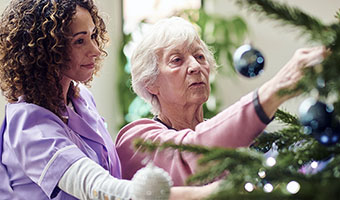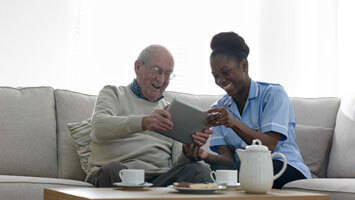How Senior Home Care Can Help Restore Your Loved One's Active Lifestyle
If it were up to Leslie Tennyson’s 85-year-old dad, he would be happy to sit at the computer and play games or watch TV on most days.
She saw that first-hand after her dad took a tumble last spring and broke a bone in his hip. The spill sent him first to the hospital and then to a rehabilitation center before he could go back to his home in St. Augustine, Florida, with a care plan to continue his exercises.
“The problem is, he didn’t do them,” says Tennyson. So, she hired a physical therapist to come to his home twice a week to work on exercises to keep him active.
“It absolutely was helpful,’’ said Tennyson, who is now using this experience to guide her in selecting future home care services for her dad.
“Once he got the push, he could drive himself to the grocery store and get back to cooking -- a hobby he enjoys,” she said. “He needed some motivation.”
“Taking It Easy Is Risky”
Staying active is one key to maintaining physical, emotional and psychological health for all adults and is especially true for aging adults.
While older adults may worry that becoming active may result in injury, the National Institute of Health (NIH) says staying sedentary is more damaging.
“Studies show that ‘taking it easy is risky,’’ the NIH says. “For the most part, when older people lose their ability to do things on their own, it doesn’t happen just because they’ve aged. It’s usually because they’re not active.”
According to a U.S. Surgeon General’s Report on Physical Activity and Health , there’s a price to pay for inactivity. Inactive people are nearly twice as likely to develop heart disease as those who are more active. And a lack of physical activity also can lead to more visits to the doctor, more hospitalizations and more use of medicines for a variety of illnesses.
Tennyson said her dad’s surgery and subsequent therapy was the “slap in the face I needed” to start looking for home care services that will soon be necessary. The experience helped her recognize that she needs to look for a provider who will push her dad to continue his active lifestyle and one who will incorporate his hobbies.
The benefits of physical activity, according to that U.S. Surgeon General report, are numerous. Such activity has been shown to:
- Maintain the ability to live independently, while reducing the risk of falling
- Reduce the risk of dying from coronary heart disease and of developing high blood pressure, colon cancer and diabetes
- Improve stamina and muscle strength in people with chronic, disabling conditions
- Reduce symptoms of anxiety and depression, while fostering well-being
- Maintain healthy bones, muscles and joints, and controls joint swelling and pain linked to arthritis
And if that isn’t enough, consider the benefits of maintaining social activities. The National Institute on Aging (NIA) points to research and studies that show aging adults who continue hobbies and social interactions are:
- Less like to develop certain diseases and may be at a lower risk for developing health problems, including dementia
- More likely to live longer
- Happier and less depressed
- Better prepared to cope with loss
Health and Outlook Improved
Like many family caregivers who struggle with bouts of caregiver guilt, Tennyson is cognizant that she likely doesn’t push her dad enough or recognize how to get him to pursue his hobbies.
But it is now at the top of her list of questions to ask a professional caregiver because she saw first-hand how her dad's health and his outlook improved.
She said she wants to hear a potential provider ask her dad what his hobbies are, what he enjoys doing around the house and she will then ask for a care plan to continue those activities.
Tennyson is looking for professionals to empower her dad, not enable him.
“I want him to be as independent as possible," says Tennyson. “I don’t want him to give in physically or emotionally. The organization that appeals to me will not just do the function, but will produce a positive attitude and atmosphere.”
Speaking of Staying Active
There are four areas to concentrate on for your parent to remain or to get active. You can help Mom or Dad work on these a little each day. None of the exercises below require a gym membership and many activities can be done at home with the help of a home health care professional. Remember to have your parent talk with a doctor before beginning any exercise program.
Endurance
These activities get the heart pumping and increase breathing. Focusing on endurance helps with everyday activities like walking up stairs and shopping. Encourage your parent to:
- Rake leaves or sweep the floor
- Dance
- Take a brisk walk or bike ride
Strength
These help your parent’s muscles stay stronger and can help him or her with activities like keeping up with grandchildren and carrying groceries. Encourage your parent to:
- Grab a tennis ball and grip and release for several times in each hand
- Use a can of vegetables as a small weight and lift, do arm curls and push it toward the ceiling
- Stand behind a chair, with his or her hands on the back for balance and come up on the toes and come back down, then repeat several times
Balance
Falling is a crucial worry among aging adults and for a good reason, as one in four Americans aged 65-plus falls each year. Focusing on balance exercises can make your parent more stable and reduces falls. Encourage your parent to:
- Stand behind a chair and using it for stability, raise a leg and hold it up for a few seconds
- Walk heel-to-toe in a straight line
- Check out a YouTube video on basic Tai Chi and follow along on the exercises
Flexibility
These exercises are stretches that will help your parent remain limber. Staying limber will help him or her get dressed, put on shoes and take down or put away items on shelves. Encourage your parent to:
- Sit on a bench or the floor and extend one leg and bend their upper body toward the leg. Switch legs
- Throw a towel over the left shoulder, holding with the left hand and grabbing the towel’s other end with the right (behind the back). Use the left hand to pull the right hand up the spine. The right arm should be relaxed as the towel is pulled with the left. Pull only to the point of resistance and hold this position for 30 to 60 seconds. Repeat on the other side
It is important to know about staying active is that doing something is always better than doing nothing. Starting slow is better than never starting.
You or your professional caregiver can also help Mom or Dad map their progress by keeping a daily log.













